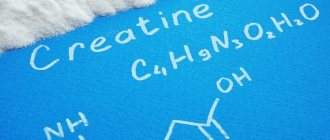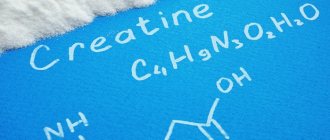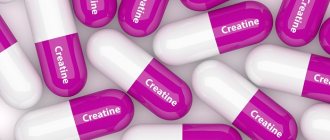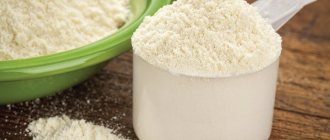Many sports dietary supplements do not contain something essential. So does creatine. This supplement has proven effectiveness, but it may well be synthesized in the body. We get creatine phosphate from amino acids, that is, with a sufficient amount of protein food. If there is a protein deficiency, the supplement will solve the problem of insufficient creatine. The overall goal of its use is to increase strength and training output. Creatine is used in bodybuilding, crossfit, powerlifting and general amateur fitness. It is suitable for men and women, and can be used during adolescence. This is a supplement without side effects for a healthy person. But many trainers believe that its use is not necessary. Why is this happening?
Chemical structure
Creatine phosphate is a derivative of amino acids. It is mistakenly called an amino acid, although from a chemical point of view it is a metabolite.
To synthesize creatine, our body uses:
- Methionine;
- Glycine;
- Arginine
That is, technically, it is enough to simply eat protein foods, and the body itself will “make” the required portion of creatine to maintain the contractile activity of muscle fibers.
Interesting fact: foreign athletes massively prefer wild fish and farm beef. The reason is simple - the meat of trained animals contains about 20% more creatine and amino acids. But poultry, conventionally produced veal and farmed fish are “weak” options for replenishing creatine reserves.
Why should we take creatine if we already have to eat large amounts of meat in order to stay strong and beautiful? Creatine phosphate has been repeatedly recognized as a revolutionary supplement in sports nutrition. It's simple. Heat treatment of meat and fish leads to the reverse breakdown of the substance into amino acids. Thus, the body has to synthesize creatine again from amino acids. All this does not allow us to consider meat the optimal product for obtaining creatine phosphate.
In addition, the less heat treatment, the more creatine the meat contains. Few people are ready to eat raw fish and rare steaks every day. And it is not safe for digestion.
Why should creatine be taken separately?
Unlike other protein metabolism derivatives, creatine is difficult to obtain from food. Only a person who consumes about 2 g of protein per 1 kg of body weight has a chance. Agree, there are not many of these among non-professional athletes. Therefore, even for the purposes of regular fitness, it makes sense to take creatine separately, as an additional food supplement.
Creatine is hardly metabolized in the body when taken as a supplement. It goes straight to the muscles and is stored there. The average athlete can store up to 450 g of creatine phosphate per month. How much do you need for active training? Various sources give figures of up to 20-30 g per day. For ordinary people - about 5-8 g. At the same time, the average dosage of creatine announced by companies selling sports nutrition is about 5 g.
Even theoretically, it is impossible to obtain such an amount of creatine from food. You need to eat several kilograms of meat per day. This will quickly lead to failure of the digestive system.
CREATINE. NEEDED OR NOT? HOW TO TAKE CORRECTLY.
Duration of taking creatine monohydrate
Creatine is an unusually stable substance and is able to remain in the human body for a long time. That is why, when loading with creatine, all experts advise limiting yourself to five to six days of taking 20 grams per day. Subsequently, subject to a maintenance course, the high level of the substance in the muscles will remain for twelve weeks, and only then will it decline.
When taking creatine according to the standard regimen, experts advise limiting it to two months and taking a break. By the end of the period of use, a sufficient amount of the substance has accumulated in the muscles to maintain tone until the start of the next period of use. Even with a reserve.
How does creatine affect the body?
Is creatine needed for normal body function? Modern sources on sports medicine classify it as an essential substance. Creatine affects the following processes in the body:
- "Mobility" of cholesterol. This term refers to the ability to remove “bad” cholesterol and transport “good” cholesterol. Creatine affects the health of the cardiovascular system and can indirectly be considered a means of preventing high blood pressure;
- Increased lactate threshold. The lactate threshold is the body's ability to resist the effects of lactic acid. If you consume creatine, the body's performance will increase due to;
- Fluid retention and binding. This effect applies only to the muscles, and causes a pump during training, and a more “full” appearance after it;
- Improving oxygen supply to white muscle fibers, and, accordingly, improving their performance;
- Improves overall performance during training through fluid retention and improved angles.
Contrary to popular belief, creatine does not help “heal joints” or “fill” them with joint fluid. It only improves metabolic parameters, but does not affect joint health.
Who should stop taking creatine?
By analogy with any other drug used by bodybuilders, creatine has an effect not only on the muscles, but on the entire body as a whole. In this regard, there are several categories of people for whom the use of the product is contraindicated.
These include:
- people with intolerance to this drug, allergies and similar reactions;
- athletes with chronic kidney disease;
- athletes with asthma;
- athletes with chronic diseases of the gastrointestinal tract;
- pregnant and breastfeeding women;
- teenagers. In them, creatine can not only cause even more acne, but also cause improper development and formation of organs.
When purchasing a product based on creatine, you must familiarize yourself with the composition and find out if there are any substances that can cause allergies.
Creatine in sports
Creatine supplements are popular in strength sports. Indeed, this is a godsend for a bodybuilder who likes bulky muscles and just wants to look big. There is an opinion among bodybuilders that creatine can be used constantly while bulking, and at the very beginning of cutting, too, in order to maintain the speed of metabolic reactions.
But athletes who need to stay within a weight class are not very fond of creatine. It is known from practice that with the help of creatine supplements you can gain 2-3 kg of weight. Again, after stopping creatine, this weight quickly disappears, but many people don’t like the idea of gaining weight, so they are against creatine supplements.
In strength sports and bodybuilding, creatine promotes:
- Rapid muscle pumping, this is especially noticeable when taken together with arginine;
- Mass growth;
- When used together with selective androgen receptor modulators – acceleration of anabolic processes and a significant increase in strength;
- When used “solo” - an increase in strength indicators for the duration of use;
- Overcoming the “power plateau”;
- Accelerating metabolism by gaining muscle mass;
- Increasing the efficiency of the heart;
- Glycogen binding and more efficient muscle function;
Performance boost
You can find information that creatine increases performance by 35%, which contributes to both strength and endurance. Moreover, the effects of creatine are not directly anabolic and therefore do not affect the athlete’s hormonal system.
It works indirectly. Creatine retains water, muscles plump up faster. This requires more oxygen consumption, improves blood circulation and muscle nutrition. As a result, a person breaks through a strength plateau. It turns out that the pumping effect helps to overcome a strength plateau and a plateau in endurance due to creatine.
Muscle pumping itself promotes:
- Increased oxygen supply;
- Glycogen retention
Creatine thus helps indirectly increase strength endurance. The normal effect of taking it is that the athlete learns to overcome heavy loads in a multi-repetition mode. Thus, working weights can increase from 50% to 60-70 of 1 RM in basic exercises. Over time, this leads to an increase in the athlete’s fitness and strength indicators.
Conclusion: creatine does not affect the human hormonal system. It is also not a selective androgen receptor modulator. It simply promotes the retention of glycogen and water in the muscles, which mechanically increases their performance. Creatine helps you become stronger and more resilient, but all this happens with an increase in the athlete's own weight.
"Filling" with water
Many bodybuilders specifically drink salty mineral water and increase the salt content in their diet during the off-season. This should promote greater endurance and strength, and serve as a means of injury prevention. Creatine works in much the same way. Its “mission” is to retain water. In the offseason, this could be promising in terms of injury prevention.
Important: “filling with water” also improves the biomechanical characteristics of the muscles, and therefore serves as a good way to prevent injuries resulting from poor technique.
“Filling” can also have side effects. It is a common cause of cramps, as an imbalance of mineral salts and water is created in the body. When performing heavy approaches in this condition, the athlete should always use the help of a spotter. The problem with cramps is solved by additional consumption of potassium and magnesium, but this also leads to a slight decrease in the amount of water in the muscles.
Increasing the amount of fluid in the muscles is considered beneficial, but it must be borne in mind that this point is not suitable for those who have problems with kidney health and high blood pressure.
Muscle growth
So, creatine starts the process of increasing the supply of blood and oxygen to the muscles. With adequate training loads, its use will also contribute to the growth of muscle mass. Creatine “gains mass” only when all conditions for normal protein synthesis are present. The athlete must eat normally and recover. Otherwise, creatine will be a useless supplement. These are not anabolic steroids to correct lack of regimen, lack of nutrition and too heavy, incorrectly selected training programs.
The work of creatine can be schematically represented as follows:
- When loading it in the muscles, fluid retention also occurs;
- A muscle pump leads to increased oxygen consumption and increased blood circulation;
- Amino acids that enter the body through nutrition are used for muscle growth;
- Anabolic processes are also supported by the partial resynthesis of creatine into amino acids;
- When increasing strength indicators, this scheme works better
So, creatine really helps you recover faster and build muscle. What about other sports indicators?
Maestro Pain about creatine
Creatine and kickback
This substance is deservedly “disliked” by beginners who became acquainted with the phenomenon of creatine withdrawal too early. What it is? Over time, the substance accumulates in tissues, and all metabolic processes are concentrated on its removal. The body stops accepting creatine and simply tries to get rid of its excess. There is no point in drinking more. The athlete must stop taking it.
When you stop taking creatine, the following happens:
- The substance accumulated in the muscles is removed from the body;
- The liquid retained by it is “drained”;
- The body no longer looks the same - the muscles become flatter;
- Endurance indicators drop;
- Pumping disappears
Important: recovery from creatine is never complete. If you compare dry mass indicators before and after a course of creatine, they will differ.
It is advisable to cycle creatine intake according to your training plan. That is, when an athlete reaches the peak of strength, creatine supports his efforts. Then, when the reception stops, the athlete reduces the volume and intensity of the load and rests.
Creatine and bone density
Athletes supplementing with calcium and D3 may benefit from taking creatine. It serves as an indirect transport of these substances, which means that with its intake the bones are also strengthened.
Bone density is a value that depends on the athlete’s muscle mass. If muscles grow at a fairly slow, physiologically natural rate, as happens with creatine, the athlete receives stronger bones in addition to improved body quality. This allows him to be more protected from injury.
Creatine supplementation is therefore advisable in sports where there is a high level of impact and injury. There he is adjusted to the off-season, in which the athlete is engaged in general physical training.
Creatine for cutting
Some athletes practice taking creatine while cutting. But this applies to those who have already completed several cycles of it and have a fairly small percentage of body fat. Such athletes do not need to significantly deplete glycogen stores, and they remove carbohydrates significantly only in the last weeks of cutting. Creatine helps them protect themselves from injuries, since in this case high-intensity training is used during cutting.
Most people do not use creatine when cutting. They immediately begin to practice a low-carb diet, and combining creatine with it is counterproductive.
- Creatine retains glycogen in muscles.
- When cutting, the goal of the diet is to deplete glycogen reserves so that the body begins to burn fat.
- Creatine slows down this process.
- The additive retains water. It is impossible to assess the athlete's physique. This leads to irregularities, mistakes, and suboptimal nutrition and training plans.
- Creatine can contribute to the occurrence of cramps, since the water-salt balance during drying is disturbed.
- In the final stages, the supplement can become the reason why “water does not drain”, since creatine retains water, and the athlete, on the contrary, strives to get rid of it.
But when losing weight in strength sports, creatine can be used. Let's say the preparation for the competition lasts 4 weeks. 2 of them, the athlete follows a diet with a slight calorie deficit and takes creatine. Before the start, the supplement is removed, which gives “minus 2 kg” at the weigh-in, and before the competition itself, a loading dose of creatine is taken to increase performance. This weight loss scheme is quite widespread.
creatine for cutting. side effects of creatine
Course duration
Regardless of which scheme you prefer, it is worth determining the duration of the course in advance. Research data shows that creatine can be taken chronically without the risk of developing permanent side effects.
However, some studies warn athletes against this approach, linking this with the fact that constant use reduces the sensitivity of the muscles to the supplement. On average, this effect is observed after 2 months.
For the supplement to be more effective, you should take a break for 3-4 weeks every 2 months. During this time, muscle sensitivity will be completely restored.
Creatine in food
Regular herring contains 26% creatine phosphate. It can be considered a good source, but only with heat treatment its beneficial properties are reduced, and it turns out that the athlete receives even less creatine. In fact, without sports nutrition products, it will not be possible to obtain normal dosages of creatine sufficient to solve the problems of building a body. Therefore, you should either admit that sports nutrition sometimes makes sense, or abandon the idea of “breaking through a plateau” with creatine.
| Amount of creatine monohydrate in food (grams per kilogram of pure product) | ||
| Product | Creatine (g/kg) | Percentage of daily dose for an athlete |
| Herring | 8 | 26% |
| Pork | 5 | 16.5% |
| Beef | 4.5 | 15% |
| Salmon | 4.5 | 15% |
| Milk | 0.1 | 0.30% |
| Vegetables fruits | 0.01% | |
| Nuts | 0.01% | |
The creatine content in plant foods - fruits, vegetables and legumes - is so insignificant that it can be neglected. At one time they liked to promote mushrooms as a source of creatine, but the absorbable amount of it in them is negligible.
Indeed, to obtain creatine you will have to eat 4 kg of herring. And if someone is capable of such a feat, then he should know that the fish will have to be chewed raw, since cooked fish will contain even less creatine. The conclusion suggests itself - either put up with sports nutrition, or use other means of building muscle mass and recovery.
Pros and cons
Creatine is known to be revered by bodybuilders around the world, but does it really do what they claim (and what the packaging says it does)?
The short answer is yes, as long as you consume enough and no more.
By adding it to your sports diet, you will increase the amount available to your muscles.
Your muscles absorb the creatine you consume, allowing your muscles to use it for energy.
But it's all about the dose. Therefore, focus on the indicated dosage.
Dosage is important because your body can only absorb and use a certain amount of creatine per muscle cell. Although the cells can stretch a little, they cannot contain more than a certain amount.
Only a certain amount of any substance can fit into a muscle cell.
If you take too much, it simply will not enter the muscle cells, but will be excreted through the kidneys in the urine.
You don't want to waste half the supplement you buy, so you should take the recommended dose and no more.
Now let’s try to understand whether you personally need to take creatine.
Side effects of taking
Creatine has been used in the sports nutrition market for more than 30 years. During this time, no serious problems associated with its use were identified. From the first examples back in 1996 to today's advanced forms of cre-alkaline, it is a relatively safe supplement.
However, discomfort may still occur when using it:
- The gastrointestinal tract may “rebel” during loading. This is due to a short-term local disturbance of the water-salt balance and tissue dehydration;
- Cramps due to electrolyte deficiency. They can be easily prevented by supplementing with electrolytes;
- Swelling of the face;
- Increased load on the kidneys during loading;
- Vitamin and mineral deficiency
You should not start taking creatine if you have kidney problems. Otherwise, it is a safe supplement. Side effects are closely related to the beneficial properties and mechanism of creatine, so it is not possible to completely get rid of them.
Taking creatine may affect your heart health. If an athlete practices loading, or simply consumes quite a lot of creatine, his heart may experience increased stress. Lactate buffering helps increase heart rate and strength. This can lead to tachycardia, heart rhythm disturbances, and even muscle microtrauma.
Important: the fast loading scheme has a greater impact on the heart. Sometimes it is recommended that if there is a high degree of risk, simply refrain from loading creatine, and take it exclusively at an even background.
Before/after meals
It is unlikely that the instructions for use of creatine preparations in the “Method of administration and dosage” section will indicate the specifics of taking creatine in relation to food. There is a lot of controversy on this topic. According to a common misconception, the acidic environment of the stomach can destroy creatinine, and therefore it is better to take the drug before meals - the absorption rate will increase.
Creatine is a real helper in the growth of “lean” muscles
Modern research has confirmed that creatine is not destroyed in acidic environments, and therefore the use of the product is always allowed. Experts generally recommend taking the drug strictly between meals. However, if the rule is sometimes broken, there will be no negative effect.
How to take creatine correctly
There are two options for taking creatine. You can drink it with a load, or you can drink it without it. Proponents of the first format believe that this way the supplement starts working faster, and you can get benefits from using it almost immediately. The second option is milder in terms of side effects and prevents the body from retaining too much water or suffering from excess creatine. But the athlete will only feel the effect of the supplement for 2-3 weeks.
Loading involves consuming 20 g of pure creatine per day. This indicator does not depend on the athlete’s own weight. Loading increases supplement consumption quite significantly and may be too costly for some athletes.
In this case it is accepted as follows:
- 10 g in the morning, immediately after 1 meal, with sweet juice;
- 2 hours before training – about 7 g;
- In the evening after dinner - the remaining 13 g
- In all cases, creatine is drunk with sweet juice or water.
Once the peak is reached, and this becomes visible in muscle fullness and tolerance to training, it will be possible to reduce the dosage to maintenance. This is 5-6 g of creatine per day. The maximum duration of taking the supplement is 8 training weeks, then for a couple of days the dosage is reduced to 2-3 g, and then the creatine is completely “turned off”. How much rest do you need? There is no clear opinion on this matter. Athletes usually adjust the intake of such supplements to their “massing” and “cutting” cycles. Standard cutting lasts about 8 weeks, eliminating creatine for 12 weeks will help achieve the goal of reducing body fat.
The regimen for taking creatine without loading is simple. 5-6 grams before training, with sweet juice or any sweetened drink, 2.5 grams before and after training, no special benefits.
Note: Cre-alkaline has a different loading pattern. You need to follow the manufacturer's instructions, which we see on the packaging.
How to take CREATINE? (Loading efficiency and side effects)
Optimal dosages of creatine
The human body is capable of absorbing up to fifty milligrams of the drug per day. Therefore, taking this drug in quantities of more than seven grams per day is unproductive. The entire remainder of the product will be eliminated in the urine.
A huge number of athletes using the creatine loading method consume twenty grams per day. This dosage should be maintained for up to five days - then the muscles will be filled to capacity with creatine. Next, the drug is taken in small doses in order to maintain concentration.
Is downloading the most efficient? Definitely not. According to research, the end result in both cases will be the same. In the case of loading, the first changes will appear a little earlier, however, by the middle of the course, muscle growth rates in both cases level out.
Top Creatine Phosphate Supplements
Creatine can be found in all brands of sports nutrition:
- Optimum newtrition;
- Ultra;
- Biotech, Dimatize, others
Domestic sports nutrition manufacturers are not lagging behind, and each offers us their own versions of creatine.
Types of additives
Manufacturer brands more or less cope with the task of supplying high-quality creatine. This supplement is difficult to spoil, so it makes sense to consider only the types of creatine
Creatine monohydrate . It loads quickly, as you can consume up to 50 g of creatine per day. It is well absorbed by the body, does not contain any impurities or additives, and is easy to use.
Creatine phosphate . This is a cheaper supplement with lower bioavailability. Therefore, you need to exceed the dosage recommended by the manufacturer by about a quarter so that the body absorbs all the creatine provided.
Creatine with transport system . An option for those who don’t want to waste time searching for sweet juices and drink a lot of tea. It is convenient to stir it and drink it before training to satisfy the body's need for creatine. Usually creatine with transport is the most expensive, so for loading they take regular one, and this one they simply drink before training to reduce the time spent on taking supplements.
Creatine hydrochloride . This is an innovative product designed to provide all the benefits of creatine without flooding your body with water. Designed for those who want to maintain a drier, more toned appearance. In fact, creatine hydrochloride does not have any proven advantages over monohydrate, so you should decide for yourself whether to purchase it or not.
Interesting fact : creatine is often added to industrially produced gainers. There are also special products containing caffeine, carnitine and creatine. They are designed to help those who have problems gaining weight gain muscle mass. Creatine promotes the retention of glycogen and water in the muscles, its use helps to quickly gain weight. But as soon as you stop taking the gainer, the “water” will drain away.
The same goes for pre-workout mixtures with amylopectin, creatine, and caffeine. They allow you to work out your workout more efficiently, work as a mild pre-workout complex, increase energy and concentration, promote fluid retention in the tissues, but after taking them, a “rollback” is inevitable.
All types of creatine have approximately the same effect from a physiological point of view. There is no creatine that will help you gain weight without rebound, or otherwise allow you to maintain results on its own. Judging by the reviews, even innovative forms of creatine still provoke “flooding” of the body with water, which is quite natural.
Negative sides
Yes, creatine has several disadvantages, but it is worth noting that they are quite minor. Thus, the substance tends to accumulate water in muscle cells. You should stop using creatine if the athlete often experiences swelling: when taking this substance you need to drink water, which can only worsen the situation. Some athletes, after taking the drug, note the appearance of intestinal spasms, nausea and indigestion. Individual intolerance should also not be ignored.
Another disadvantage of creatine is the possible occurrence of dehydration, which occurs with minimal water consumption. You should not remove excess water with medications, as this can be harmful to health.
If you have doubts about whether you should take creatine, you can buy several samples. This amount will be enough to form your own opinion about it.
After you have become familiar with the pros and cons of creatine, what this product provides and how to take it, you can make a choice of drug.
Bottom line
Creatine has been on the market for a long time and has been well studied. It really helps build muscle mass and increase working weights. This supplement promotes recovery after strength training, it helps break through the “plateau” in results and increase both muscle volume and mass. Creatine is suitable for most athletes, it does not contain stimulants and is not addictive. It is used in all strength sports and sometimes in training sprinters and crossfitters. It is enough to choose high-quality creatine and build your training plan so that the activity is truly aimed at increasing muscle mass.
The only “natural” supplement that works to increase mass and strength!
Igor February 1, 2019
Pros and cons of creatine
Creatine is a completely natural and approved nutritional supplement that makes it possible to increase the energy potential of an athlete. Nowadays, the diet of athletes is rarely complete without this supplement. It helps to quickly realize achievements in sports. This substance has its positive and negative qualities.











